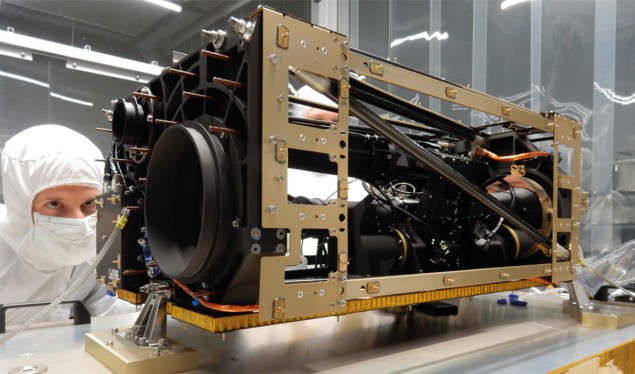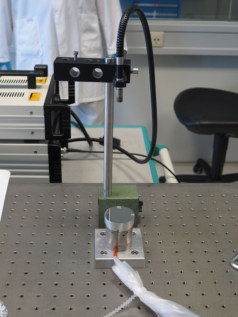Bespoke tip/tilt systems designed by Physik Instrumente for scientific missions such as the European Space Agency (ESA)’s Solar Orbiter could pave the way for high-volume applications in space-based optical communications and industrial materials processing

Today’s space probes represent a modern miracle of precision engineering. Take ESA’s Solar Orbiter as an example, which in 2020 embarked on a 10-year mission to study the dynamics of the Sun by flying closer to the star than any previous spacecraft. Onboard the 1.7 tonne satellite are 10 separate instruments that have been carefully optimized to capture the most accurate scientific data while also surviving the extreme temperatures the satellite will be exposed to during its journey around the Sun.
One of those instruments, the Polarimetric and Helioseismic Imager (PHI), will measure the Sun’s magnetic field to investigate important dynamical features of both the solar surface and its interior, such as how energy is transported between different layers. “The PHI instrument measures the polarization of the incoming light,” explains Reiner Volkmer of the Leibniz Institute for Solar Physics, a member of the project team. “Two images are taken in succession in different polarization states, and one is subtracted from the other. This is done for different polarization directions to calculate the magnetic field strength and direction.”
For accurate results, each of the images must come from exactly the same position on the solar surface, which means that the mirror of the PHI’s high-resolution telescope must always be pointing in the same direction – despite the constant movement and vibrations of the spacecraft. “A movable optical element is needed in the light path of the telescope to correct for the jitter,” comments Volkmer, whose team was responsible for designing an image stabilization system for the PHI. “By correlating two sequential images we can calculate the deviation in position from one to the other, and the mirror is then moved to compensate for the deviation.”
Piezoelectric control
The mirror must be moved quickly and precisely enough to correct for small vibrations in real time, and the solution chosen by the project team was a tip/tilt system that exploits piezoelectric actuators to dynamically adjust the angular position of the mirror in two orthogonal directions. Designed and developed by Physik Instrumente (PI), a German company that specializes in precision positioning technologies, the piezoelectric tip/tilt unit is light and compact enough to be integrated into the PHI instrument, and robust enough to endure both extreme temperatures and the mechanical shocks that occur during launch.
Inside the tip/tilt system are four piezo actuators arranged in pairs. All of the actuators control the movable platform at the same time, which ensures a common pivot point and delivers the same precision and dynamic properties in all directions of motion. This design scheme, known as parallel kinematics, is particularly important for achieving faster response times and for moving heavier loads – such as the relatively large mirror needed for the PHI’s telescope. “With a stacked solution, a serial kinematic, we would have different dynamic properties and angular errors in the x– and y-axes,” explains Lukas Rau, PI’s product marketing manager for piezo systems. “A piezo tip/tilt unit is also more compact because only one device is needed to control angular motion in the two axes.”
One of the big advantages of using piezoelectric actuators for space applications is that there is no relative movement of mechanical parts inside the system, which means there is no friction, no wear, and no need for lubrication or maintenance. The piezoelectric materials used for the actuators expand and contract in response to an applied voltage, while flexible joints provide a friction-free mechanism to guide the movement of the platform. A stictionless preload design integrated into the tip/tilt unit adds stiffness that protects the actuators against tensile forces when they move at high dynamic frequencies or through large angular deflections.

The stiffness of the piezo-based design also imbues the system with a high resonant frequency, which enables more dynamic movements and more stable control. “There is always a trade-off between operating frequency and the amount of angular travel,” explains Rau. “Devices with a larger angular motion range deliver typically lower dynamic frequencies, while faster systems need a stiffer design that allows only a smaller movement.”
PI now offers a wide range of commercial off-the-shelf mirror mounts, thanks to five decades of experience in supporting beam-steering and stabilization applications in aerospace, astronomy and space exploration. These include piezo-driven systems that can be optimized to deliver the dynamic properties and angular motion needed for a specific application, as well as magnetic voice-coil tip/tilt units that typically enable larger movements at slightly slower speeds.
For the PHI instrument, meanwhile, the piezo tip/tilt unit had to be specially designed to meet the exacting demands of the image stabilization system. “We searched the market for suitable devices, and selected one that was close to our requirements,” says Volkmer. “We then contacted PI to see if they could modify the component to meet our specifications.”
Custom design
The starting point was a commercial device, the S-340, but significant changes were needed to enable the tip/tilt system to move the PHI’s mirror at high enough frequencies to support image acquisition rates of up to 1200 frames per second. While the standard component offers an angular displacement of 2 mrad and a resonant frequency of 1 kHz for a load of 63 g, the device designed for the PHI had to move a mirror weighing 71 g through a displacement of ±295 µrad with a resonant frequency of 1.3 kHz . “Increasing the required resonant frequency even by just a small amount needs a different design,” comments Rau.
Further modifications were needed to ensure that the system could operate effectively in space conditions, particularly the extreme temperatures the Solar Orbiter will face as it approaches the Sun. “The cabling had to be adapted to cope with a wide temperature range, and we had to introduce new soldering techniques to meet the required NASA/ESA standards,” says Rau. During the eight years it took to design and build the image stabilization system, PI engineers worked closely with the Leibniz team to adapt the component design, ensure easy integration with the PHI’s optical system, and conduct the extensive testing needed to qualify the tip/tilt unit for use in space flight and launch. “It was a really good co-operation with PI,” comments Volkmer. “Development was needed on both sides, and they put in the the effort to make the necessary changes.”
We are experts in motion and positioning, and we partner with our customers to find the best solution for their application.
Lukas Rau, PI’s product marketing manager for piezo systems
PI has now developed several bespoke tip/tilt systems for such one-off space projects, while Rau believes that the same technologies could soon find mass-market appeal for a new generation of space-based optical communications systems that are being planned to provide fast Internet connections anywhere in the world. “The Solar Orbiter is an extreme project that allows us to demonstrate our capabilities, but the business case for other space applications is becoming more attractive,” he says.
Rau points out that companies such as Amazon and SpaceX have started to deploy thousands of satellites into low-Earth orbit, creating constellations of spacecraft that will exploit laser beams to communicate with each other – and in some cases, the ground. One of the big challenges for these free-space optical (FSO) systems is sustaining the laser links between adjacent satellites as the constellation moves through space and the relative positions of the satellites keep changing.
“The whole system is moving, there is vibration in each satellite, and there are also aberrations that arise from changes in humidity, temperature and turbulence in the atmosphere,” says Rau. “It’s a very dynamic system, and the position of the mirror needs to be corrected quickly enough to maintain the optical connections.”
PI’s tip/tilt systems can achieve the fast dynamics needed to stabilize these optical data links, and are also small, light and cost-effective enough to be integrated into the much smaller satellites that will be deployed in these low-Earth orbit constellations. To improve precision, integrated sensors measure the motion of the platform to calibrate the device and eliminate the effects of hysteresis.
Industrial options
Other commercial applications exploit the highly dynamic angular motion that can be achieved with a tip/tilt unit to steer a laser beam across a surface. This scanning capability is widely used, for example, to inspect semiconductor wafers for defects or contaminants, or to move a light beam across a sample in an optical microscope. Another emerging application lies in laser materials processing, where a tip/tilt system can be used to oscillate a high-power laser beam on the workpiece, allowing faster cutting speeds while avoiding the build-up of heat that can sacrifice quality.
“The basic requirements for these different applications, whether in space or in industry, are often the same,” comments Rau. “They only allow a small space for integration, they require precise and highly dynamic beam steering in two axes, and they need friction-free operation for extra long uptime without the need for maintenance. There are not so many other solutions that you can use.”
Rau explains that PI works closely with its clients to design and supply tip/tilt systems that are optimized for their needs, whether for a bespoke project like the Solar Orbiter or for commercial applications that require volume production of large numbers of devices. “Many aspects need to be thought about to find the right product,” says Rau. “We are experts in motion and positioning, and we partner with our customers to find the best solution for their application.”




